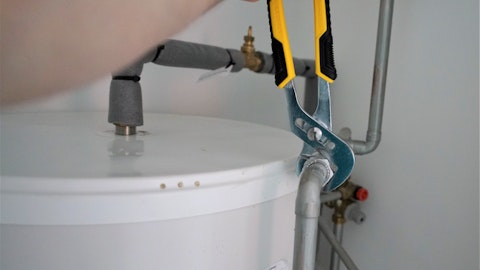David Manthey: Great. Thank you.
Operator: Our next question comes from Trey Grooms from Stephens. Go ahead.
Trey Grooms: Hi, good morning, everyone. I guess, first on the guide, I’m backing into an EBIT margin kind of in that low teens range. Melanie, is there anything we need to be aware of as far as kind of the cadence here as we look at the balance of the year?
Melanie Hart: Yes. No. So if you’re backing into that for the full year, I think that’s pretty reasonable. When you look at just kind of top line, the comps that we’ll have in the third quarter, where we were still up 10% for base business year-over-year are going to be more difficult than the fourth quarter where we were just up 1%. We did start to see some of the slowdown in new construction in – starting out in the fourth quarter, primarily kind of November, December of last year. So when you look at kind of the year-over-year comps, those should get relatively easier in the fourth quarter. And then third quarter, we’ll also have that one less selling day, as well.
Trey Grooms: Yes. Okay. Got it. And then kind of sticking with the guide. As we kind of look at the revised EPS guidance range here and Pete, I understand why you would have confidence in the guide given where we are in the year, and I appreciate the color you gave around that prior question. But looking at that range, what would kind of drive us to be more at the top end or the bottom end of that range? Is that – given that confidence you have, do you think that, that would be more of a top line driven swing or potential fluctuations in margins that could get us there.
Melanie Hart: The biggest driver there is going to be where we end up on the top line, kind of within that range bracketing that down 10%. So that will get us to the high and low end of the range. There’ll be some expense offsets that will depend on the actual volume, but margins should be relatively similar in both case scenarios.
Peter Arvan: Volume, as you know, volume leverage is by far our biggest lever.
Trey Grooms: Yes, that’s all. Super helpful. Thank you, I’ll pass it on. Good luck.
Peter Arvan: Thank you.
Operator: The next question comes from Scott Schneeberger of Oppenheimer. Go ahead.
Scott Schneeberger: Thank you very much. Good morning. Pete or Melanie, could you – you covered weather very well on the first question from Ryan. But I’m curious, you mentioned it was a $60 million to $70 million impact in the first quarter. When we’re at this point next year, looking back on 2023, how much would you say is the – will have been the weather impact from this year on a year-over-year basis? I guess, is there an update to $60 million to $70 million is what I’m asking?
Melanie Hart: We have estimated for second quarter around $30 million. .
Scott Schneeberger: Incrementally, so $90 million to $100 million, Melanie?
Melanie Hart: Yes. That’s correct.
Scott Schneeberger: Okay. Thanks. I appreciate that. And then, Peter, you had said, I think it was your part in the prepared remarks, that remodeling was trending ahead of what you had originally expected for the year. Now that you’re halfway through the year and had a chance to look at it. But then you kind of softened the commentary and said, but it looks like it’s getting worked through pretty well. Could you elaborate on that, please?
Peter Arvan: Yes. I looked at – we looked at the permit activity and what we believe is happening on new pool construction and how we triangulated on that, we look at those two products that I mentioned, new pool finish – our pool finish and tile, knowing that those two products only go into two things. One is a renovation and new pool construction. So the new pool finish, as I mentioned in the second quarter was up 2%. And that number for – earlier in the year, was – I’m sorry, new pool finish was down 2% for the second quarter, kind of similar to what it was in the first quarter, but it was skewed. So when I looked at how – the end of the second quarter plays out with pool finish and tile, like it’s moderating a little bit, meaning that it started out better and then has moderated a little bit.
And given that we don’t really see a big movement in new pool construction, my only conclusion is, is that – some of that has to do with renovation and remodel. Now keep in mind, when we look at renovation and remodel, what I’m not saying is that our expectations are any different. I just think that when you look at the guide we gave related to new pool construction – I’m sorry, related to renovation and remodel, being down 15% to 20%. I think that it’s going to be skewed more heavily towards the beginning of the year being better. And then as they work through the backlog, we think it will be weaker towards the back half.
Scott Schneeberger: Okay, great. Thanks so much.
Operator: The next question comes from Joe Ahlersmeyer from Deutsche Bank. Go ahead.
Joe Ahlersmeyer: Thank you very much. Just a couple of questions from my end. First, on the – just a follow-up from earlier, I think you said negative 5% was the 2Q impact from new construction. That’s not that the category was down 5%. It’s that it was a five-point impact to the consolidated number. Is that correct? And then just thinking about the cumulative change in the sales guide from earlier in the year, let’s take sort of the initial midpoint down 1% to 2% and then now we’re at 10%. Can you maybe bucket that eight to nine point change in sort of – and I know this is a lot, but four different buckets, kind of one, things that are pushed to next year, so that maybe is the deferrals that you talked about things that are current year circumstances like weather that really have nothing to do with next year.



